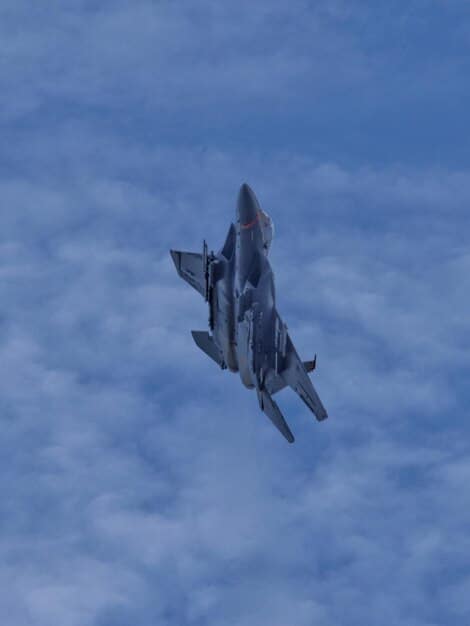F-35 vs F-15EX: Key Performance Differences in 2025

The F-35 and F-15EX represent distinct strategic approaches in air warfare, with the F-35 excelling in stealth and network-centric operations due to its advanced sensor fusion and low observable design, while the F-15EX leverages its robust payload capacity and high speed for air superiority and strike missions, offering a modernized, cost-effective alternative to maintain air dominance in 2025.
Understanding What are the Key Performance Differences Between the F-35 and F-15EX in 2025? is crucial for military strategists and enthusiasts alike. This comparison reveals divergent philosophies in modern air combat, each aircraft optimized for unique roles within a complex battlefield. We’ll delve into their capabilities, tactical applications, and strategic implications for the coming years.
Evolving Roles and Design Philosophies
The F-35 Lightning II and the F-15EX Eagle II, while both formidable combat aircraft, embody vastly different design philosophies and strategic roles for the 2025 operational environment. The F-35, a stealthy, multi-role fighter, was conceived as the cornerstone of 5th-generation airpower, prioritizing survivability in contested airspace through low observability and advanced sensor fusion. Its design is intrinsically linked to network-centric warfare, aiming to serve as a flying command and control node, integrating disparate data streams into a unified tactical picture for pilots.
In stark contrast, the F-15EX Eagle II represents the modernization of a proven 4th-generation airframe. Its lineage traces back to the venerable F-15 Eagle, renowned for its undisputed air superiority capabilities. The F-15EX eschews stealth for raw power, speed, and immense weapons carriage capacity. It is designed to operate in conjunction with 5th-generation assets, leveraging its ability to carry a large volume of ordnance and operate at high speeds, particularly in less contested or permissive environments. This dual approach signifies a recognition of varying operational needs and fiscal realities within modern air forces.
Stealth versus External Payload
One of the most apparent distinctions lies in their fundamental design choices regarding stealth and payload. The F-35’s core strength is its low observable (LO) technology, which significantly reduces its radar cross-section, infrared signature, and radio frequency emissions. This stealth capability allows the F-35 to penetrate heavily defended airspace, detect threats at long ranges without being detected, and engage targets with a high degree of surprise and survivability. However, integrating weapons and fuel internally to maintain its stealth profile limits its external carriage options, typically reserved for less contested scenarios.
- F-35: Prioritizes stealth, internal weapons bays for primary combat loads, reduced radar signature.
- F-15EX: Designed for heavy external payloads, including up to 22 air-to-air missiles or extensive air-to-ground ordnance.
- Operational Trade-off: Stealth for initial penetration vs. capacity for sustained engagement or strike.
The F-15EX, on the other hand, embraces an unburdened external payload philosophy. Its airframe is robust enough to carry an impressive array of weapons and external fuel tanks, making it a “missile truck” or a deep strike platform with considerable endurance. While it lacks the stealth capabilities of the F-35, its raw capacity ensures that it can deliver more firepower per sortie in situations where survivability isn’t strictly dependent on stealth. This allows for a complementary role where the F-35 might open the door, and the F-15EX can follow to deliver volume effects or maintain sustained air patrol.
Looking ahead to 2025, militaries are focusing on a concept of “digital stealth,” emphasizing not just physical low observability but also electronic warfare and network integration. Both aircraft will contribute, but in different ways. The F-35 will continue to lead penetration missions, while the F-15EX will operate in roles that require high sortie generation and mass, or as a stand-off shooter linking to 5th-generation sensor data.
Avionics and Sensor Fusion: The Core Difference
The true strategic divergence between the F-35 and the F-15EX often lies not in their visible airframes, but in their digital brains. The F-35’s combat effectiveness is fundamentally built upon its unparalleled sensor fusion, a defining characteristic of 5th-generation warfare. Its sophisticated avionics suite, including the AN/APG-81 Active Electronically Scanned Array (AESA) radar, the Distributed Aperture System (DAS), and the Electro-Optical Targeting System (EOTS), continuously collects vast amounts of data from multiple sources. This raw data is then seamlessly processed and fused by the aircraft’s central computer, presented to the pilot as a single, easily interpretable, and highlyaccurate tactical picture on the helmet-mounted display.
This comprehensive situational awareness allows F-35 pilots to “see” threats and friendly forces far beyond what traditional cockpits offer, often without needing to maneuver or emit detectable signals. The system effectively turns the aircraft into a “flying supercomputer” capable of identifying, tracking, and engaging targets with unprecedented precision, while also sharing that fused data with other networked assets. This capability is critical for operating in complex, anti-access/area-denial (A2/AD) environments where information dominance is paramount.
Radar Capabilities and Electronic Warfare
Both aircraft feature advanced AESA radars, which provide superior detection range, multi-target tracking, and electronic protection compared to older mechanically scanned radars. The F-35’s AN/APG-81 is optimized for stealthy target detection and engagement, capable of operating in passive modes to avoid detection. Its electronic warfare (EW) suite is deeply integrated, offering cutting-edge self-protection and offensive EW capabilities that can jam enemy radars and communications, further enhancing its survivability and mission effectiveness in hostile airspace.
- F-35 APG-81: Optimized for stealth, passive detection, and integrated offensive/defensive EW.
- F-15EX APG-82(V)1: Powerful AESA radar with extensive range, precision targeting, and advanced jamming.
- EW Integration: F-35’s AN/ASQ-239 Barracuda suite offers comprehensive electronic attack and protection. F-15EX also has advanced EW capabilities, but not as deeply integrated for stealth operations.
The F-15EX, equipped with the AN/APG-82(V)1 AESA radar, boasts incredible range and resolution, making it exceptionally proficient in air-to-air combat and traditional air-to-ground precision strikes. Its EW suite, the Eagle Passive/Active Warning and Survivability System (EPAWSS), is a significant upgrade, providing advanced threat detection, jamming, and deception capabilities. While formidable, the F-15EX’s EW is designed to protect a larger, less stealthy aircraft in a high-threat environment, rather than enable deep penetration undetected. The F-15EX’s systems enhance its capacity to counter advanced threats and operate as a formidable conventional fighter, complementing the F-35’s stealth-first approach.

Crucially, the F-35’s system is designed for broad network integration, allowing it to seamlessly share its fused tactical picture with other F-35s, 4th-generation fighters, ground units, and even naval assets. This “force multiplier” effect means that a single F-35 can significantly enhance the situational awareness and lethality of an entire networked force, acting as a critical node in distributed lethality concepts for 2025 onwards. The F-15EX, while capable of data linking, does not possess the same level of fused sensor data processing and dissemination designed for covert, network-centric operations.
Performance Metrics: Speed, Range, and Maneuverability
When comparing the F-35 and F-15EX strictly on traditional performance metrics like speed, range, and maneuverability, we observe distinct strengths that align with their respective design philosophies. The F-15EX, as a derivative of a pure air superiority fighter, maintains a significant edge in raw kinematic performance. Its two powerful engines allow it to achieve higher maximum speeds, particularly at altitude, and accelerate with greater alacrity.
This superior speed is crucial for roles requiring rapid interception, quick egress from a contested area after a strike, or for maintaining energy advantage in a dogfight. The F-15EX’s robust airframe is also designed for high g-loads, offering exceptional maneuverability that has made the F-15 family legendary in close-quarters air combat. While modern air combat increasingly relies on beyond-visual-range (BVR) engagements, the ability to maneuver aggressively remains a critical backstop for unexpected scenarios or for evading incoming threats.
Operational Range and Endurance
Range and endurance are vital for projecting air power across vast distances. Both aircraft are capable of transcontinental flights with aerial refueling, but their unrefueled combat radii and loiter times differ. The F-15EX, especially when carrying external fuel tanks, can boast a significantly longer combat radius and on-station time compared to the F-35, which must internally carry all its fuel to maintain its stealth profile. This makes the F-15EX a more suitable platform for prolonged combat air patrols (CAPs), long-range escort missions, or deep strike missions where extended reach is paramount.
- F-15EX Max Speed: Mach 2.5+, enabling quick intercepts and high-speed dashes.
- F-35 Max Speed: Mach 1.6, sufficient for most operational needs but lower than F-15EX.
- F-15EX Range: Extended combat radius with external fuel tanks, ideal for long CAPs.
- F-35 Range: Shorter unrefueled combat radius due to internal fuel limitations for stealth.
The F-35’s design, however, ensures that its unrefueled combat radius, while shorter than an externally configured F-15EX, is achieved while maintaining its critical stealth advantage. This means it can penetrate deeper into contested territory without needing to ditch external tanks or compromise its low observability. Furthermore, the F-35’s advanced sensor fusion and network capabilities mean it can operate more efficiently and often requires fewer sorties to achieve mission objectives compared to older generation aircraft, indirectly affecting the demand for extended range in certain scenarios.
By 2025, air forces are integrating both platforms into a flexible strike package. The F-35 would likely lead the way, neutralizing critical air defenses and establishing air superiority, while the F-15EX could follow with its massive payload to deliver sustained effects on target or assume CAP duties. The F-15EX’s higher speed and greater carriage capacity can also make it a more effective platform for carrying next-generation weapons, such as hypersonic missiles, which are often too large for the F-35’s internal bays, further diversifying their combined capabilities.
Weapon Payload and Strategic Roles
The differences in weapon payload capacity and configuration directly dictate the strategic roles assigned to the F-35 and F-15EX in 2025. The F-35’s primary weapon carriage is internal, essential for maintaining its stealth. It possesses two internal weapons bays capable of carrying a mix of air-to-air missiles like the AIM-120 AMRAAM and air-to-ground precision-guided munitions such as JDAMs or Small Diameter Bombs (SDBs). This internal bay capacity, while limited in terms of raw numbers, is perfectly suited for its role as a first-day-of-war penetrating strike fighter, where the goal is to surprise and destroy critical enemy assets before they can react effectively.
When operating in a more permissive environment, the F-35 can utilize external weapon pylons, significantly increasing its payload. However, this external carriage compromises its stealth, transforming it into a 4th/5th-generation hybrid that can deliver substantial firepower but at the cost of its signature advantage. This flexibility allows the F-35 to adapt to various mission profiles, from initial entry to sustained combat operations as air defenses are degraded.
Air-to-Air vs. Air-to-Ground Focus
The F-15EX, by contrast, is a dedicated “bomb truck” or “missile truck” by design. Its strengthened airframe and numerous hardpoints enable it to carry an enormous amount of ordnance, far exceeding the F-35’s internal capacity. It can carry up to 22 air-to-air missiles, transforming it into an unparalleled air superiority platform for situations where massed aerial engagements are anticipated. For air-to-ground missions, it can carry an extensive array of precision-guided munitions, stand-off weapons, and even large, specialized bombs that the F-35 simply cannot accommodate internally.
- F-35: Internal weapons for stealth, focus on precision and first-day entry strikes.
- F-15EX: High external payload for volume, air-to-air mass, and heavy air-to-ground munitions.
- Combined Strategy: F-35 clears the path, F-15EX delivers sustained firepower.
The strategic implication for 2025 is a complementary force structure. The F-35 will continue to lead penetrations into highly contested airspace, using its stealth and sensor fusion to gather intelligence, neutralize critical threats, and manage the battlespace. Once the initial “door-kick” is complete, the F-15EX can follow to deliver the heavy punch—whether that’s a large volume of air-to-air missiles to clear remaining enemy aircraft or a massive precision strike against hardened targets. This division of labor allows each aircraft to maximize its strengths and ensures a robust, multi-layered air campaign capacity. The F-15EX also offers a viable platform for carrying future, larger weapons, such as advanced anti-ship missiles or hypersonic weapons, further expanding its strategic utility.
Maintenance, Cost, and Fleet Integration
Beyond combat performance, the practicalities of acquisition, maintenance, and fleet integration play a crucial role in military procurement decisions for both the F-35 and F-15EX. The F-35 program has been synonymous with high development and procurement costs over its lifespan, though unit costs have steadily decreased. Its advanced systems, while offering unparalleled capabilities, come with complex maintenance requirements and higher operating costs per flying hour compared to the F-15EX. This is due to the F-35’s sophisticated stealth coatings, integrated avionic systems, and the logistics of managing a globally distributed aircraft with advanced prognostics and health management (PHM) systems.
However, the long-term vision for the F-35 involves a global logistics system (Autonomic Logistics Information System – ALIS, transitioning to ODIN) designed to streamline maintenance and reduce turnaround times, though its implementation has faced challenges. The goal is to achieve lower overall sustainment costs as the fleet matures and operational experience grows.
Acquisition and Operational Costs
The F-15EX provides a more cost-effective alternative for certain roles. Being a modernized version of an existing platform, it benefits from mature production lines and significant commonality with the legacy F-15 fleet, reducing development risks and potentially procurement costs. Its maintenance, while still requiring skilled personnel, is generally less complex and thus less expensive per flight hour than the F-35, primarily because it lacks the intricate stealth features and their associated upkeep.
- F-35 Unit Cost: ~$80M (for A model), but higher sustainment costs.
- F-15EX Unit Cost: ~$87M, but lower sustainment costs due to mature airframe and systems.
- Sustainment Challenge: F-35’s complex ALIS/ODIN system vs. F-15EX’s simpler maintenance.

For 2025, the F-15EX is attractive to air forces looking to recapitalize their aging 4th-generation fleets without the full leap to 5th-generation expenses for every platform. Countries might opt for a mix of F-35s for their leading-edge capabilities and F-15EXs to augment their capacity, provide air superiority in less contested areas, or serve as dedicated weapons carriers. This “high-low” mix strategy allows for a broader spectrum of operations while managing fiscal limitations.
Fleet integration also involves pilot training and existing infrastructure. F-15EX pilots can transition more easily from older F-15 models due to familiar flight characteristics, whereas F-35 pilots require extensive training on its unique sensor fusion and flight control systems. This also impacts the speed at which new aircraft can become operational. Ultimately, the choice between, or combination of, these aircraft is a strategic balance between advanced capability, operational flexibility, and long-term economic viability.
Future Technologies and Adaptability
The landscape of air warfare is continually evolving, driven by rapid advancements in technology. Both the F-35 and F-15EX are designed with an eye toward future upgrades and the integration of emerging capabilities, positioning them for continued relevance beyond 2025. The F-35, being a software-defined aircraft, possesses inherent advantages in its ability to adapt to new threats and missions through iterative software Block upgrades. This architecture allows for the seamless integration of new sensors, weapons, and AI-driven decision aids without extensive hardware modifications, a process that is often more challenging for conventionally designed aircraft.
Looking forward, the F-35 is slated to receive advancements in its processing power, sensor capabilities, and electronic warfare suite, ensuring its technological edge in an increasingly complex battlespace. Its network-centric design also makes it a prime candidate for teaming with unmanned platforms, such as Loyal Wingmen drones. These AI-controlled aircraft could extend the F-35’s sensor reach, carry additional weapons, or act as decoys, further enhancing the F-35’s survivability and lethality by distributing risk and capability.
Open Architecture and Hypersonic Weapons
The F-15EX, while not a 5th-generation stealth platform, is also designed with an open architecture avionics system, allowing for relatively straightforward integration of new technologies. This means that, despite its 4th-generation airframe, it can incorporate advanced sensors, communications systems, and even some AI capabilities over time. Its robust design and ample internal volume make it a strong candidate for carrying future large-format weapons, including air-launched hypersonic missiles that would likely not fit into the F-35’s internal bays. This capacity positions the F-15EX as a viable platform for delivering high-end, next-generation munitions that are too large for stealth-optimized aircraft.
- F-35 Software Advancements: Continuous Block upgrades for sensors, AI integration, and new weapons.
- F-15EX Adaptability: Open architecture for upgrades, capacity for large future weapons like hypersonics.
- Unmanned Teaming: F-35’s network forms the core for future loyal wingman integration.
By 2025, air forces worldwide will be exploring various options for manned-unmanned teaming (MUM-T). The F-35, with its unparalleled ability to collect, fuse, and distribute data, is positioned as the command node for such operations, orchestrating the actions of multiple unmanned assets. The F-15EX could also participate in MUM-T, likely in a role that leverages its payload capacity to carry larger drones or deploy a swarm of smaller, expendable UAVs. Both aircraft therefore possess significant growth potential, although their adaptation pathways reflect their distinct foundational designs and strategic roles. Ultimately, the ability to rapidly incorporate new technologies will be a key determinant of their long-term relevance in an ever-changing threat environment.
| Key Performance Aspect | Summary of Differences |
|---|---|
| stealth & sensors | F-35 excels in low observability and sensor fusion; F-15EX focuses on powerful AESA radar and EW (less stealth). |
| payload capacity | F-15EX offers significantly higher external weapon loads; F-35 has limited internal bays for stealth operations. |
| speed & range | F-15EX is faster and has greater unrefueled combat range; F-35 sacrifices some speed for stealth. |
| cost & maintenance | F-35 has higher sustainment costs, F-15EX offers a more cost-effective modernization of F-15 platform. |
Frequently Asked Questions
The F-35 is designated as a 5th-generation fighter primarily due to its advanced stealth capabilities, integrated sensor fusion, and networked operations. These features allow it to operate effectively in highly contested environments, gather vast amounts of battlefield data, and share it seamlessly with other assets, offering an unprecedented level of situational awareness to the pilot and the larger force.
The F-15EX’s primary role is to act as a complementary force multiplier alongside 5th-generation aircraft like the F-35. It is designed to carry a vast arsenal of air-to-air and air-to-ground weapons, functioning as a “missile truck” or a deep strike platform in less contested airspace. Its high speed and range also make it ideal for quick reaction alerts and prolonged air superiority patrols.
Sensor fusion in the F-35 integrates data from all onboard sensors (radar, EW, targeting systems) into a single, comprehensive, and intuitive display for the pilot. This reduces cognitive load, significantly enhances situational awareness by providing a complete picture of the battlefield, and enables faster, more informed decision-making, allowing the pilot to focus on tactical execution rather than data interpretation.
Yes, the F-15EX is being developed with the capability to carry and launch future hypersonic weapons. Its robust airframe and substantial external payload capacity make it a suitable platform for these larger, next-generation munitions, which typically would not fit within the internal weapons bays of stealth-optimized aircraft like the F-35. This expands its strategic strike options.
While the F-35’s unit acquisition cost has decreased, its sustainment costs per flying hour are generally higher due to its complex stealth features and advanced systems. The F-15EX, being a modernized version of an existing platform, often benefits from lower operational and maintenance costs due to commonality with prior F-15 versions and less complex stealth-related upkeep.
Conclusion
The performance differences between the F-35 and F-15EX in 2025 underscore a strategic evolution in air warfare, rather than a simple competition. The F-35, with its unparalleled stealth and sensor fusion, is designed to dominate in contested environments, providing critical situational awareness and precision strike capabilities. Conversely, the F-15EX offers a potent blend of speed, payload capacity, and modernized avionics, ideal for air superiority in less contested spaces and delivering significant conventional firepower. Their combined deployment creates a formidable layered defense and offense, leveraging the unique strengths of each platform to address the multifaceted challenges of modern and future air combat, ensuring air dominance across a spectrum of operational scenarios.





